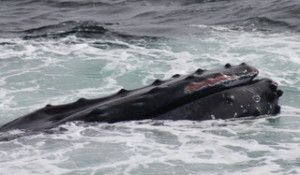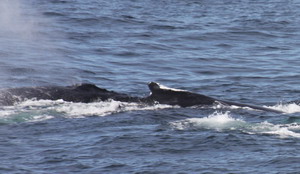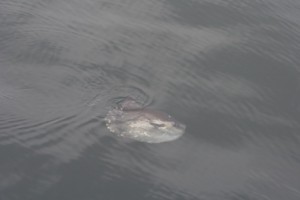Dolphin Fleet Naturalist Notebook 27 September to 3 October
While the rough seas and high winds on September 27 and 28 kept Dolphin Fleet boats in port, by September 29th we were champing at the bit to find out if the storms had brought any new animals into the area. Sure enough, it seemed as through the churning seas had altered the distribution of small fish in such a way that we saw humpback whales feeding at the surface for the first time in months!
Humpback whales come to Stellwagen Bank and other rich areas in the North Atlantic primarily to feed. In this area, their main source of food is the sand lance, a six-inch long schooling fish. Sand lance will frequently bury themselves in the sandy substrate of the ocean floor; however, this doesn’t stop the humpbcks from finding them! Humpback whales will often use their jaws to stir up these submerged animals, with tell-tale scrape markings on their jawlines evidencing that behavior, as seen in the photo below.
While this behavioral detective work is gratifying, it’s much more exciting to find these animals feeding at the surface, which is what we found today. As these whales blew clouds of bubbles to trap and confuse schools of sand lance at the surface, the water appeared to boil, and we waited anxiously for these whales to emerge through the centers of the bu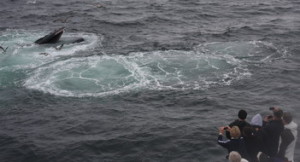 bble rings, their mouths filled with hundreds of pounds of food.
bble rings, their mouths filled with hundreds of pounds of food.
Salt, one of our most famous humpbacks and also one of our most prolific mothers, was accompanied by her calf, Sanchal. Although this calf is only 8-9 months old and still predominantly relying on its mothers milk for sustenance, Sanchal appeared to be joining in on the feeding frenzy. Having given birth to at least ten calves over the past 30 years, Salt is obviously a good teacher, and seemed to be showing her calf how and where to get the most out of its meal!
Salt and Sanchal
On 30 September we returned to the same area to find that feeding had subsided, but several humpbacks were still hanging around. Two male humpbacks, Coral and Rocker, were engaged in rather active social behaviors, which started soon after we approached. It started as Coral spyhopped, bringing his large eye completely out of the water. Immediately afterward, Coral jumped completely out of the water in a full spinning breach! After this single breach, Coral rolled over on his back and spent the next 20 minutes 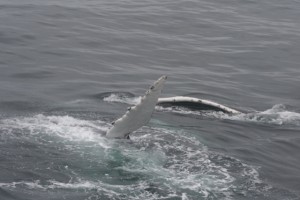 flipper slapping. We don’t know exactly what these active surface behaviors mean, but they are throught to play a role in social behaviors. Certainly Rocker seemed interested, and frequently he came so close to Coral that it looked like they would collide or that Coral would whack Rocker with his flipper! Rocker seemed to respond to this by occasionally lobtailing, or throwing his tail out of the water. We can only speculate as to what these animals were communicating to one another in this interaction.
flipper slapping. We don’t know exactly what these active surface behaviors mean, but they are throught to play a role in social behaviors. Certainly Rocker seemed interested, and frequently he came so close to Coral that it looked like they would collide or that Coral would whack Rocker with his flipper! Rocker seemed to respond to this by occasionally lobtailing, or throwing his tail out of the water. We can only speculate as to what these animals were communicating to one another in this interaction. 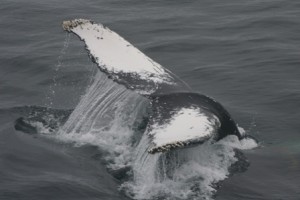
Our mid-day trip on October 1st started with a more unusual sighting when we spotted a tall, triangular dorsal fin flopping and bobbing in the surf. This could be only one thing: the mola mola, or ocean sunfish. These pancake-shaped fish can reach rather large sizes, sometimes exceeding diameters of five feet! As their day-to-day life involves drifting around on ocean currents, looking for jellyfish and other planktonic organisms on which to prey, they have evolved very thick, tough, skin, which serves as a protection against potential predators which might be drawn to its otherwise passive lifestyle.
We continued to head north and located three humpbacks, who also happened to be in the vicinity of a pod of Atlantic white-sided dolphins. Dwarfed by the colossal masses of the 40-ton humpbacks, these dolphins could be seen darting back and forth underneath our bow.
Because humpbacks are so well known for their active surface behavior, we were especially surprised to see a pair of fin whales rolling at the surface in what seemed to be a social behavior. In general, fin whales tend to be rather elusive, and we consider ourselves lucky to catch extended looks at them when they quickly surface. Today, we got spectacular looks at their long, sleek bodies (sometimes over 70 feet long!) as well as the striking white of their bellies.
October 2nd started as a rainy morning, but as the Dolphin VIII left the dock, the skies cleared and it turned into a very pleasant day for whale watching, despite the increasing wind. After being lured northward by a humpback who spouted and surfaced once, never to be seen again, we turned around and headed southward toward a group of four humpbacks. Soon, we were able to recognize the familiar flukes of Canopy and her calf, Pele, and Milkweed. Canopy’s calf asserted some independence and seemed to split off from the group, but seemed to want some attention for this act, as suggested by its full breach! Mom didn’t seem to respond to this, and the calf continued to chin breach repeatedly until the group turned and headed back towards the calf, eventually reuniting.
October 3rd was another blustery day, and high winds and rough seas made it a bit more challenging to locate and reach the areas where we suspected the same group of humpbacks would still be hanging out. Our passengers today had particularly good spout-spotting skills, and many of them were able to catch a brief glimpse of the elusive fin back whale as we passed it on our way northward. Soon, we came across Whisk and her calf, as well as two other humpbacks who we hadn’t seen in quite a while. Perseid and Pepper, both mature females who had calves last year, surfaced and fluked in sync with Whisk and her calf. Soon, the lobtailing began. One of the humpbacks began repeatedly smacking its tail down on the surface of the water. This seemed to attract the attention of three more whales in the area, as Pele, Canopy and the calf soon appeared and joined the group. The lobtailing continued, and as we ran out of time and headed for Provincetown, we could still see the spouts and flukes of this group grow smaller behind us as we headed back to port.






